About life in exile, anarchic art, and the “black milk” of the earth: The art historian Media Farzin met her old friends Ramin and Rokni Haerizadeh and Hesam Rahmanian for conversation.
I’ve known Hesam, Ramin, and Rokni for some years; the brothers are old friends from Tehran. Despite the multi-year gaps in our conversations, each one seems to start exactly where the last one left off, a consistent and consistently expanding universe. The following touches on some of the ideas in their current show, especially the impact of the Iran-Iraq War (1980–88).
Could you tell me a little bit more about your installation?
We call this show a “landscape” rather than an installation. We tend to work on a subject for a long time. Things branch out in different ways, and then come together at a certain moment as a landscape. We have collaborators, too, artists who migrate into our shows.
Migration is an important theme here, and of course you’re migrants yourselves.
We started out, a few years ago, thinking about exile. There was the war in Iraq, and then Syria happened. We were asking why migration happens—war is so often the reason. That was personal for us, too, because we grew up with war. But we wanted to think about suffering from other angles, from marginalized places.
The poem on the wall of the Schirn exhibition, for example, “Boys and Animals”, includes a real helmet worn by an Iranian soldier, probably a young boy, during the Iran-Iraq War.
We have a series called “Unfaithful Poetries,” which are collaborative translations of modern Farsi poems. That one is based on Reza Baraheni’s long poem, Ismael, written in the early years of the Islamic Revolution and the War.
But it’s a very free translation.
It goes through multiple rewritings with a team of collaborators. They’re from various cultural backgrounds and some of them never read the original. So much of it falls away. The text is adapted to a contemporary sensibility, and then recontextualized on the wall and within the landscape.
We wanted to think about suffering from other angles, from marginalized places.
You do something similar with photography, reframing or refocusing it.
We’ve been collecting photobooks on the Iran-Iraq War, alongside films, novels, poetry—building an archive. And we interviewed a lot of veterans. Most of the photographs of that war were taken by the participants. We isolated incidental details, like the faces of young boys, out of these photos. That’s what you see with the poem on the wall. We’re interested in the untold histories, ones that aren’t part of official narratives.
Is that why you focus on the donkeys?
Animals came up in so many of the interviews: dogs, cats, donkeys especially. We wanted the viewpoints of non-human others that had participated in the war. So, with the floor piece, we were thinking about Hoorolazim.
What is that?
It’s a marshland spread across Iran and Iraq, at the south end of the Tigris and Euphrates rivers. Iranians know it as Hoveyzeh, the site of a devastating attack during the war. It used to be a beautiful area, with a distinct ecosystem and way of life. But it’s in terrible shape now. The marshes were drained, first to root out dissidents and later to dig for oil.
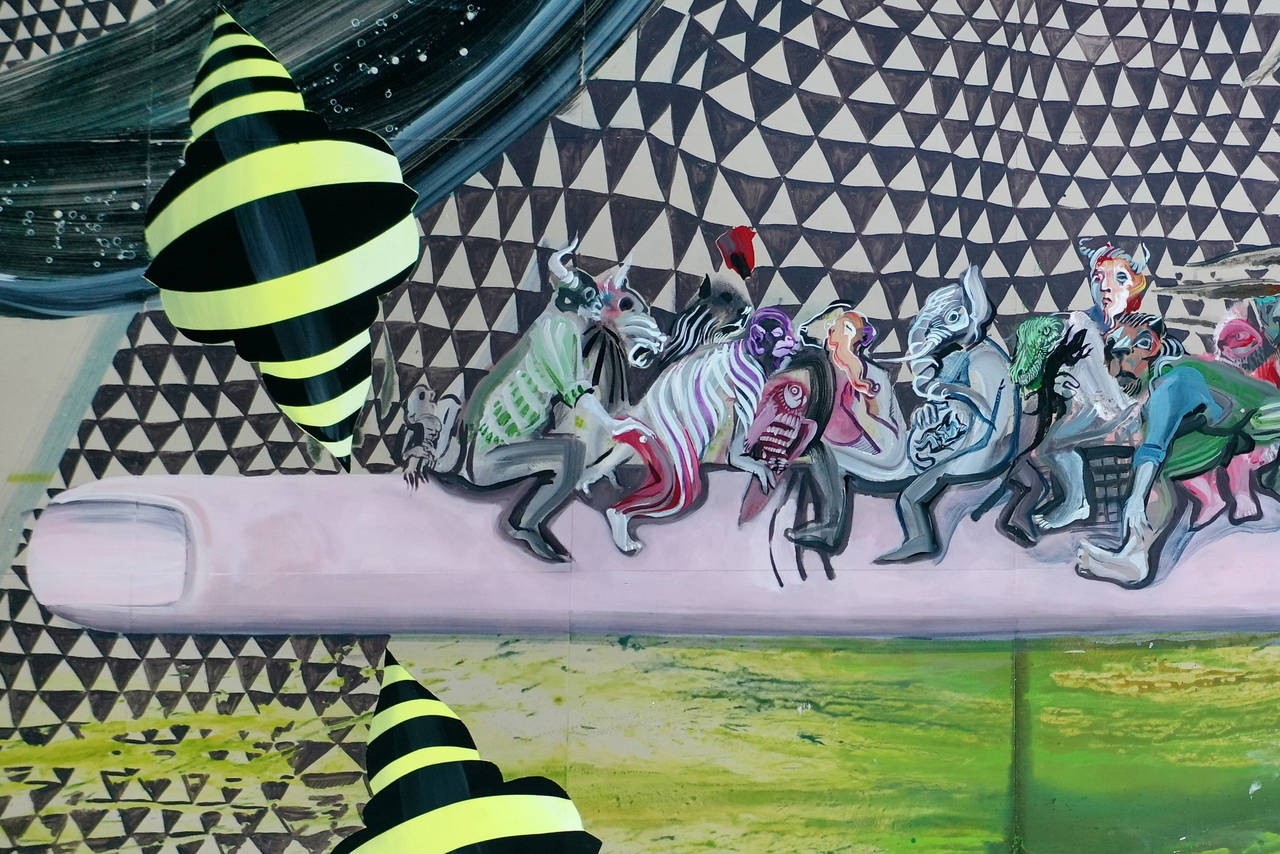
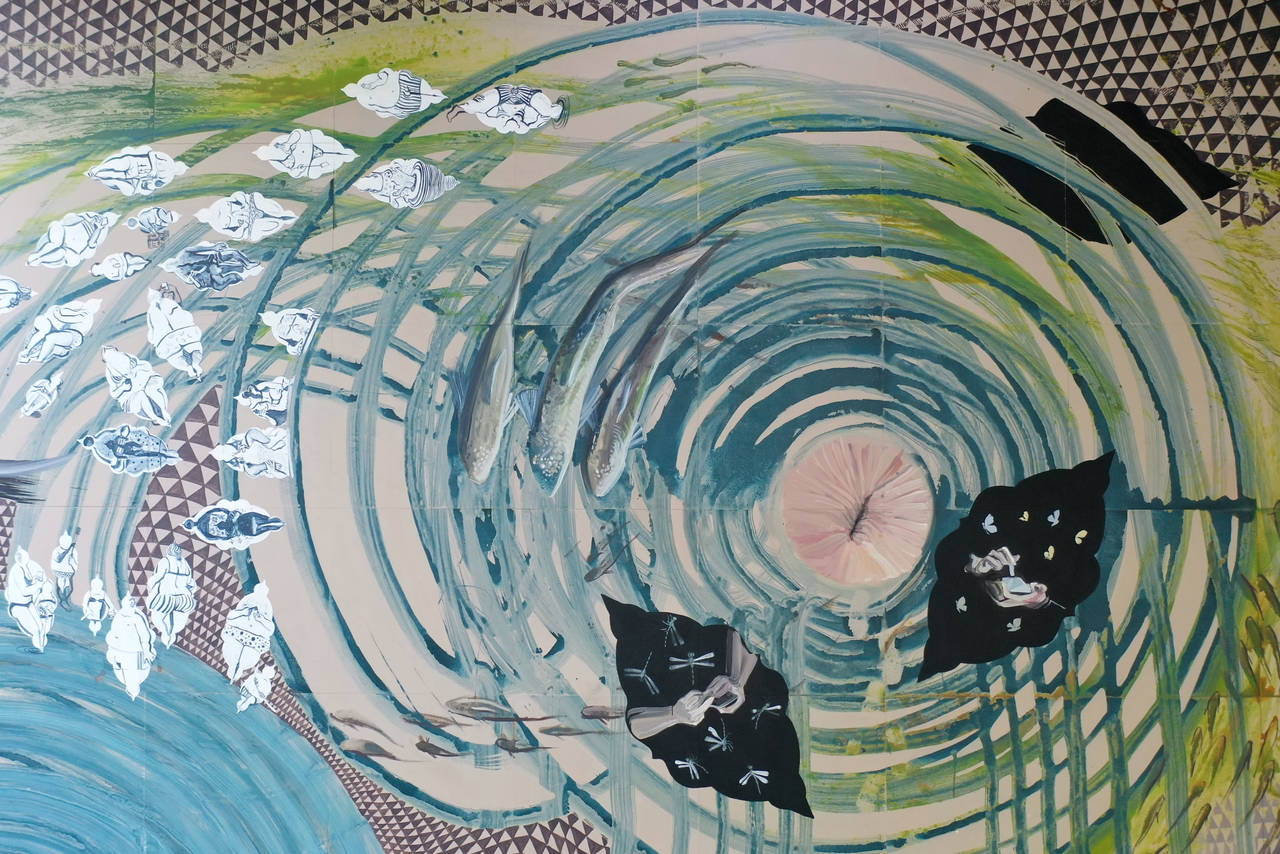
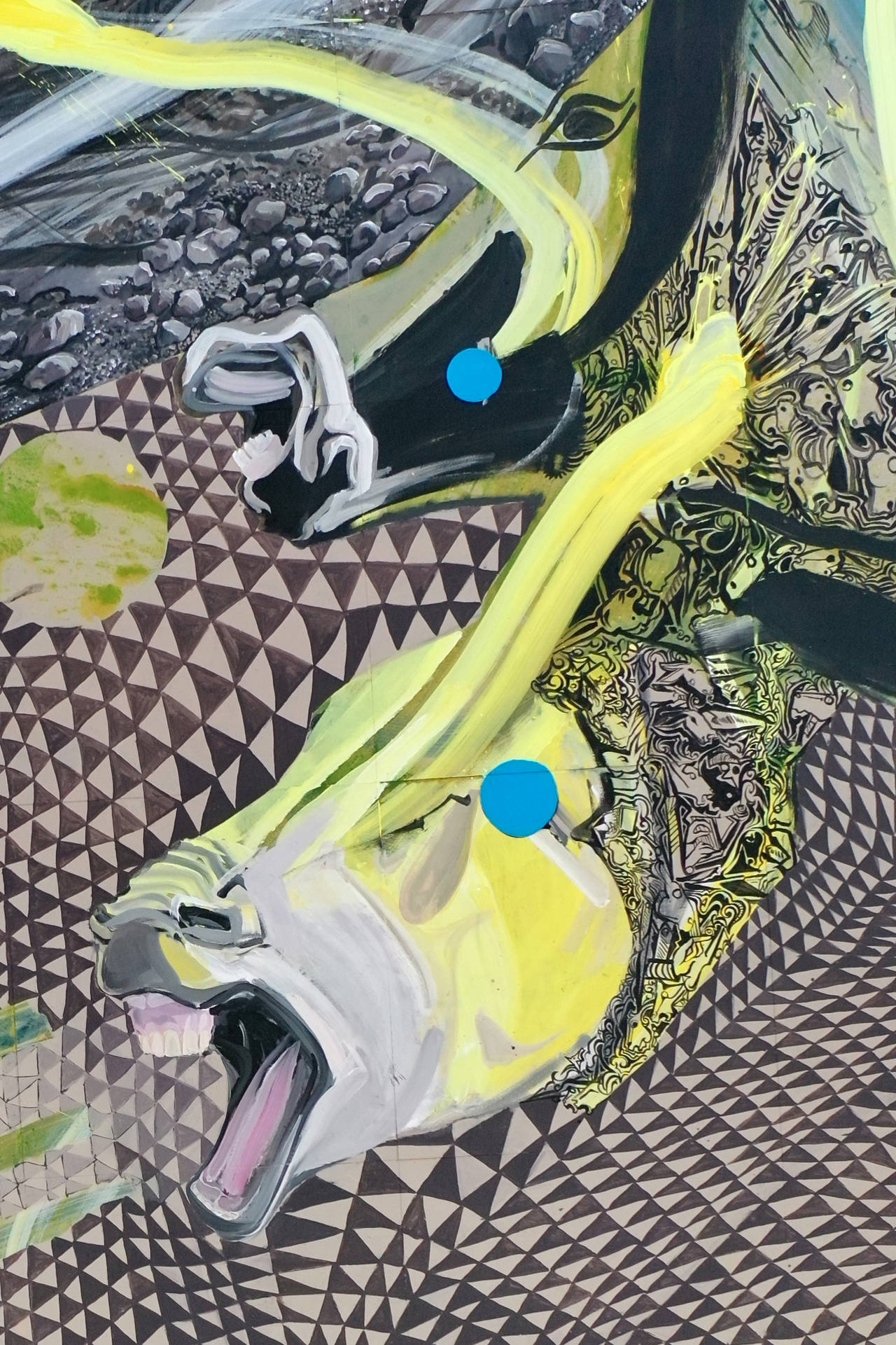
It’s not far from where you live now, in the United Arab Emirates. Was that an influence?
There were definitely things that moving to the Gulf brought to our practice. We were closer to these histories of war, the sites and the people. And the palm trees, and their triangular shadows. The incredibly strong light, and the pink aftereffect. The shallows, the pond scum, the carp; your relationship with the heat.
Were these some of the references of the floor piece shown at the Schirn?
There are so many references—we’ve actually made a booklet of visual “footnotes” to our practice. There are films, like Tarkovsky’s “Ivan’s Childhood”. Shia mourning rituals were really important, and the theatrical quality they have, and all the objects involved in Ashura ceremonies [commemorating the death of Imam Hossein]. They’re moments of grief but also festive, in the sense of people coming together. There’s a particular painting by [Iranian artist] Iran Darroudi. She was commissioned in 1969 to paint “Iranian Petroleum” for a company that was launching a pipeline in the south. It was widely circulated in magazines like Time and Newsweek.
It’s abstract, but it’s basically a portrait of a pipeline that’s gone up in flames.
[Poet] Ahmad Shamlou renamed it “Our Veins, The Earth’s Veins”. Which builds on another very visual line from the Baraheni poem, about how the world has been drinking the earth’s “black milk” for eighty years, and now the earth is demanding blood in return.
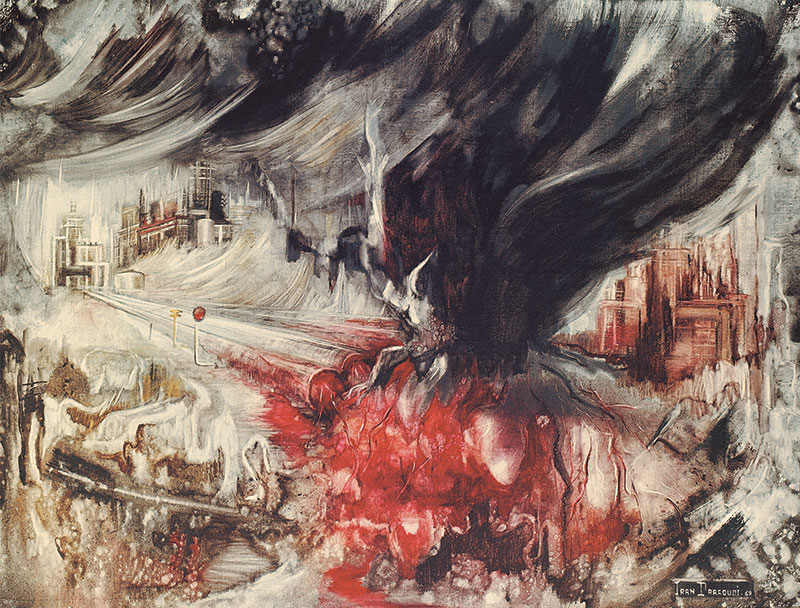
Iran Darroudi, Our Veins, The Earth’s Veins, 1969, Image via irandarroudi.com
The earth as a living entity.
The oil deposits in the Gulf, if you think about it, are the remains of the dead. They’re sucked out, made to live again. But there’s a price for reanimating the dead, and that’s war. And migration follows. That’s why we used oil pumps when making the floor piece, in the dastgahs.
Tell me about the dastgahs.
They’re an important part of our practice. We transform ourselves into machines, machine-assemblages that make the work. The idea is to move away from an intentional subjectivity, to become intuitive like an animal. A dastgah doesn’t see where it’s going. It contaminates, makes a mess. It doesn’t lay down paint: it squeezes or smears or drags it along the floor.
What does the dastgah bring to the process?
It’s important to get distance from the subjectivity that is created by the research—with the dastgah, we put all this aside. Because if the work is too neat, we’re lying. There need to be parts that are off, that make people ask, what does this have to do with anything? Where there’s a kind of magic.
That unexpectedness, that’s what we’re after.
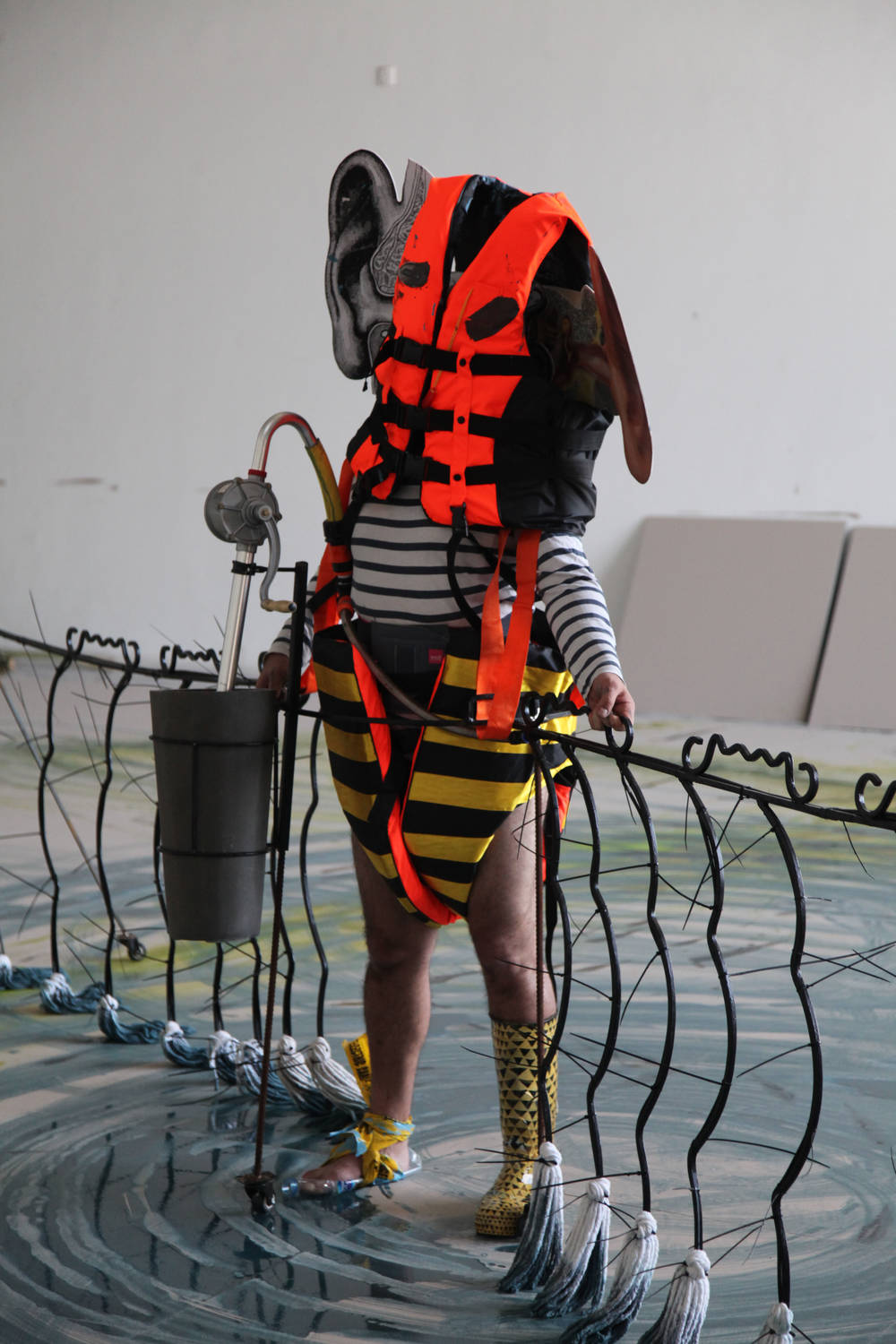
As in, magic for the viewer?
There’s a scene in “A Day at the Races”, the Marx Brothers’ film, where Groucho is pretending to be a doctor and the others are his assistants. But they start doing these strange, totally unnecessary things, like washing their hands over and over, wheeling the patient all over the place, deliberately misunderstanding requests. Their actions destabilize everything; it becomes an amazingly anarchic situation, and then takes off in another direction altogether. That unexpectedness, that’s what we’re after.
UPDATE
The SCHIRN will be closed from November 2 to 30. We'll continue to be there for you online - with exciting articles and podcasts on the SCHIRN MAG and with lots of variety on Facebook, Instagram & Co.









